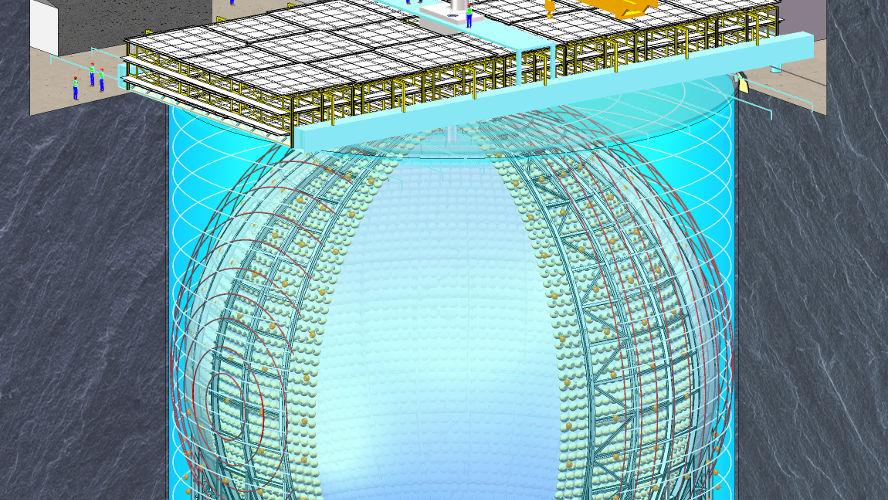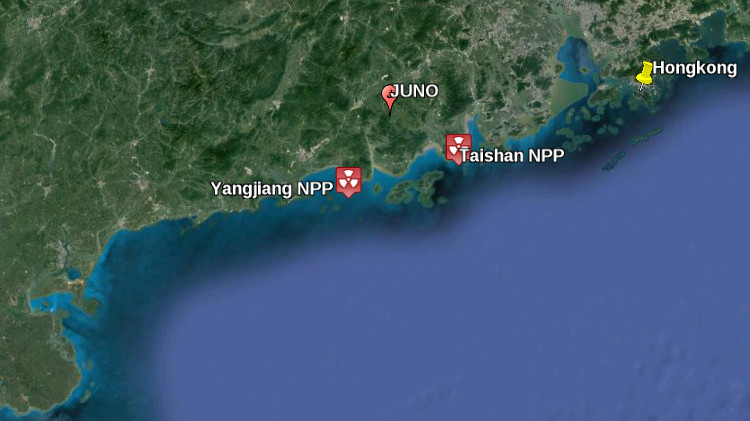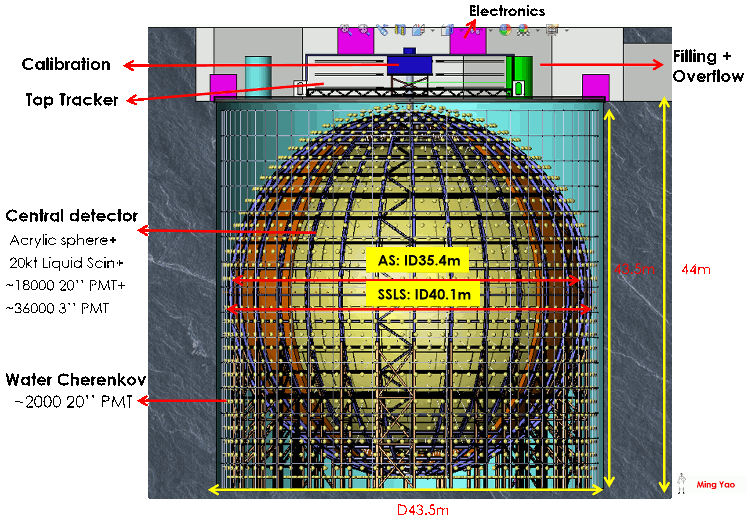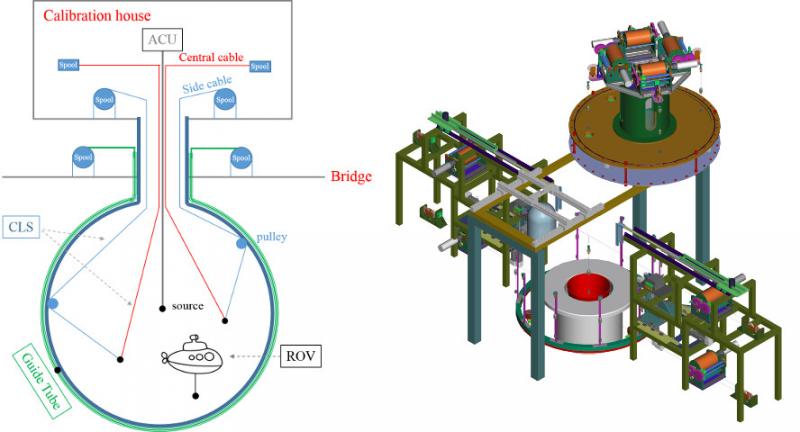
The Jiangmen Underground Neutrino Observatory (JUNO) is a multi-purpose neutrino experiment. The project was proposed in 2008 and approved in 2013. The experiment is located 700-meter underground in Kaiping, Jiangmen City, Guangdong Province in China. The location of the JUNO detector is 53 km away from both Yangjiang and Taishan nuclear power plants (NPP), which is optimized to have the best sensitivity for mass hierarchy determination. The planned total thermal power of these reactors is 36 GW which would provide sufficient electron anti-neutrinos for the JUNO detector. With a 20-thousand-ton liquid scintillator detector with 3% energy resolution at 1 MeV, JUNO is designed to determine the neutrino mass hierarchy (MH) and to precisely measure oscillation parameters by detecting reactor neutrinos. It is also a superb observatory for supernova, atmospheric, solar, and geo-neutrinos, and as well as a site for exotic decay and indirect dark matter searches.

江门中微子实验观测站(Jiangmen Underground Neutrino Observatory,JUNO)是一项旨在多项科学目标研究的中微子实验。该项目于2008年提出并于2013年获得批准立项。江门中微子实验位于中 国广东省江门市开平市、埋深为700米的地下实验室。为使实验对中微子的质量序列有最好的灵敏度,经过优化,JUNO实验最终选址在距离阳江和台山核电站 均53公里处。阳江和台山核电站的设计总功率为36GW,这将为JUNO实验提供丰富的反应堆中微子(反电子中微子)。江门中微子实验将建造一个有效质量 为两万吨、能量分辨率达到3%(对于能量为1 MeV的正电子信号)的液体闪烁体探测器。利用该中微子探测器,JUNO的首要物理目标是通过从核电站产生的反应堆中微子来确定中微子的质量序列,以及精 确测量中微子混合参数。另外,JUNO实验还将对超新星中微子、大气中微子、太阳中微子、地球中微子、惰性中微子、核子衰变以及暗物质间接探测等进行研究。
Central Detector

The central detector of JUNO is designed as an acrylic sphere with an inner diameter of 35.4 m. The central detector will be filled with more than 20 kton of liquid scintillator. 18000 20-inch PMTs and 36000 3-inch PMTs will be placed outside the acrylic sphere to collect the scintillation photons. The photocathode coverage is more than 75%. The central detector will be supported by a stainless steel truss and submersed in a pure water pool with 43.5 meter in diameter and depth. Inside the water pool, 2000 20-inch PMTs will be installed to act as an active cosmic ray veto. A muon tracker will be placed on top of the water pool. A central chimney serves as the only penetration to the central detector, which will be sealed by a house containing numbers of calibration devices above the water pool.
江门中微子实验的中心探测器主体是一个内径为35.4米的有机玻璃球,球体内将被充满超过两 万吨的液体闪烁体。有机玻璃球体的外围排布着18000个20英寸和36000个3英寸的光电倍增管,光电面的覆盖率达到75%以上。这些光电管用以收集 有机玻璃球体内能量沉积而产生的光信号。有机玻璃球体被一个不锈钢网架支撑,整个结构浸没在一个直径和深度都为43.5米的高纯水池里。在水池里,大约 2000个20英寸的光电倍增管构成反符合系统,以探测宇宙射线产生的切伦科夫信号。在水池上方即有机玻璃球的顶部,宇宙射线径迹探测器被安装以精确测量 宇宙射线的方向。中心探测器与外界唯一的连通方式是一根“烟囱”。“烟囱”的出口处与刻度室密封连接,而刻度室内则安放着数套刻度装置以对探测器进行标定 校准。
JUNO at SJTU

To reach the expected sensitivity to neutrino mass hierarchy determination, the energy resolution of the JUNO central detector energy resolution is required to be better than 3% at 1 MeV (1.9% at 2.5 MeV where the most signficant MH driven oscillation signal lies), and the absolute energy scale uncertainty to be much better than 1%. Therefore, calibration of the central detector is critical. Prof. Jianglai Liu from SJTU led the calibration level-II activities, and collaborates with University of Maryland (UMd, led by Dr. Mengjiao Xiao), Xi-an Jiao Tong University (led by Dr. Qingmin Zhang), Northwest Polytech University (Prof. Kai Luo), and Dongguan University of Technology (DGUT, led by Prof. Lei Yang). The conceptual design of the calibration system is to deploy multiple sources (radioactive or light emitter) to a wide range of positions inside the detector. The system includes an Automatic Calibration Unit (ACU, UMd) to scan the central axis of central detector, a Cable Loop Systems (CLS) to scan an off-center vertical plane, a Remotely Operated Vehicle (ROV) for a 3D scanning and a Guide Tube (GT) on the outer surface of the acrylic sphere to study the boundary effects.
为了达到对中微子质量序列预期的探测灵敏度,JUNO中心探测器的能量分辨率要求在1 MeV处好于3%或者说在2.5 MeV能量处(区分中微子质量正反序的信号区域)好于1.9%。并且,中心测探测器的绝对能标的不确定度要小于1%。因此,对探测器的刻度是实验JUNO 实验物理目标的关键。作为JUNO合作组的成员,上海交通大学的刘江来教授领导了JUNO中心探测器刻度的项目课题,并联合来自马里兰大学的肖梦姣博士、 西安交通大学张清明博士、西北工大的罗凯教授、东莞理工学院的杨雷教授的科研小组共同开展研究。为了满足实验的需求,刻度系统被设计为可以将各类源(光源 以及放射源)放置在探测内绝大部分位置,从而实现对探测器的充分刻度。交大团队设计的刻度源放置系统主要包含了四个子系统:扫描探测器中心轴的自动刻度单 元(Automatic Calibration Unit, ACU)、扫描垂直平面的悬线子系统(Cable Loop Systems, CLS)、探测器内部三维扫描的水下航行器(Remotely Operated Vehicle,ROV)以及安装在有机玻璃球外壁、扫描探测器边界的导管系统(Guide Tube,GT)。
JUNO experiment construction is expected to be completed in 2019 and to commence data taking in 2020. With 20 kton fiducial liquid scintillator mass and 6-year's data, JUNO alone can determine the neutrino mass hierarchy to a 3 to 4-σ confidence level.
江门中微子实验的建设预计于2019年全面完成,而正式的数据采集将于2020年开始。利用两万吨液闪运行6年的有效数据,江门中微子实验有望在3~4σ的置信水平上确定中微子的质量序列。
